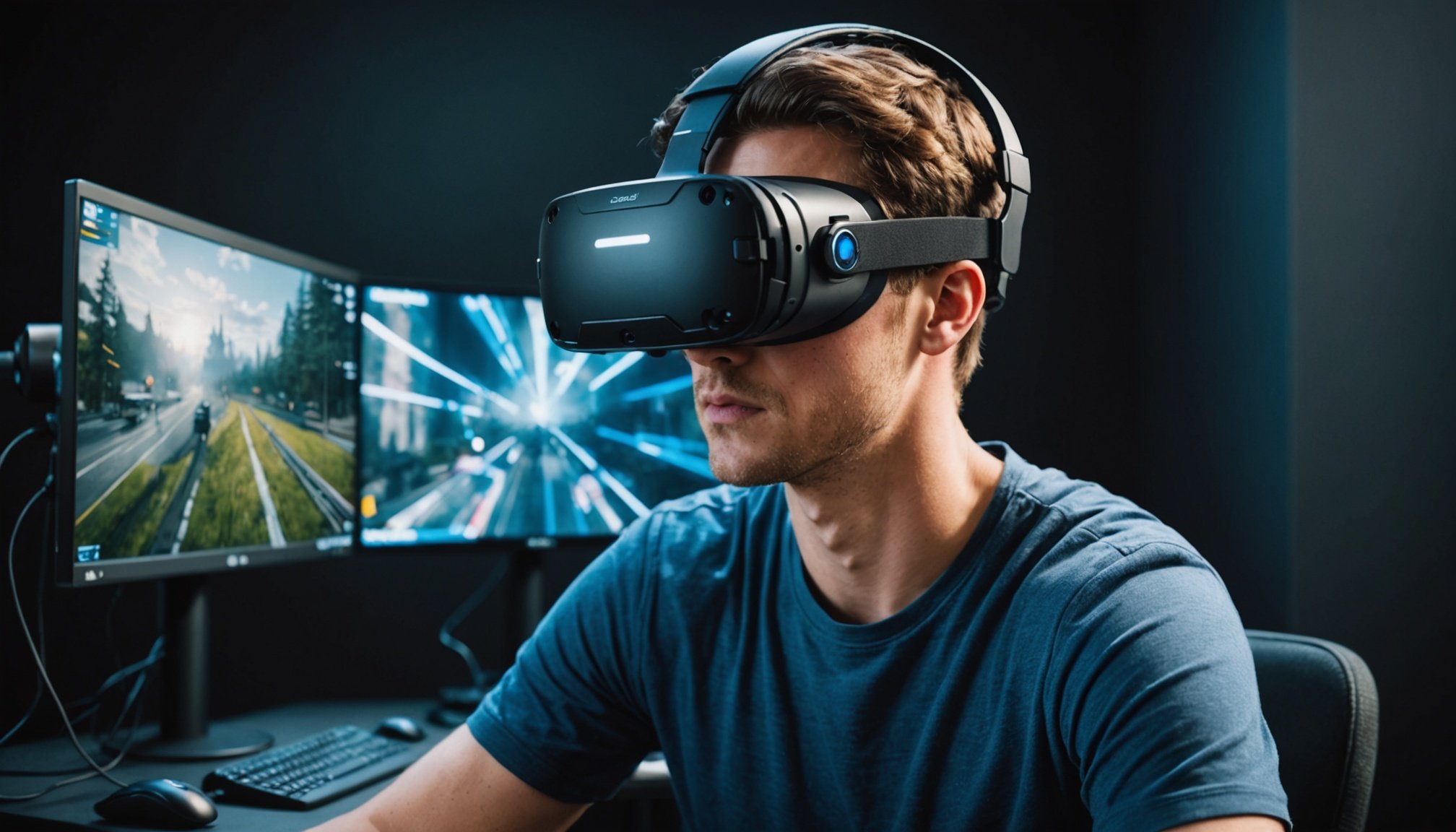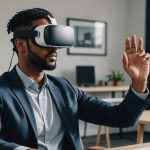Introduction to Eye-Tracking Technology
Eye-tracking technology has become a crucial component of modern virtual reality (VR) gaming, offering enhanced user engagement and richer experiences. At its core, this technology tracks the movement of a user’s eyes to inform system responses, creating a seamless interaction between the player and the virtual environment.
The importance of eye-tracking technology in VR is found in its ability to foster more dynamic and immersive experiences. By analyzing where a player looks, the VR system can adjust visual elements in real-time, making interactions more intuitive and natural. This enhances users’ sense of presence in the virtual world.
Also read : Navigating the Intricacies: Top Challenges in Developing Multiplayer Games for Next-Gen VR Platforms
Historically, the evolution of eye-tracking technology has been pivotal in VR gaming, moving from rudimentary gaze detection to sophisticated systems integrated into VR headsets. Early developments laid the foundation for today’s advancements, leveraging infrared sensors and algorithms to capture and interpret eye movements with high precision.
These innovations have not only enriched gaming but have also paved the way for enhanced accessibility and user satisfaction. Understanding the principles behind this technology is key to appreciating its contributions to the gaming industry and its ongoing transformation of virtual reality experiences.
Have you seen this : Unlocking Lifelike Forests: Expert Strategies for Boosting Immersive Woodland Adventure Games
Impact of Eye-Tracking Technology on VR Gaming Accessibility
Eye-tracking technology has made significant strides in VR accessibility, particularly benefiting gamers with disabilities. By closely monitoring eye movements, this technology enables individuals with limited mobility to engage in VR games without traditional controllers. It acts as a primary input method, allowing players to navigate and interact with virtual environments seamlessly.
The real-world benefits of eye-tracking technology are profound. For example, adaptive interfaces can be designed to respond to specific eye movements, offering a tailored experience to each user. This accessibility feature has been transformative, leveling the playing field for gamers with physical limitations and enhancing user engagement.
Several examples highlight the accessibility features enabled by eye-tracking. Adaptive gaze controls, for instance, allow players to issue commands through eye movement. This reduces the cognitive load and enhances gameplay enjoyment, especially for those who may find traditional input methods challenging.
Ultimately, eye-tracking not only opens new realms of possibility for inclusivity in VR gaming but also provides an enriching experience that caters to a wider audience. By breaking down existing barriers, eye-tracking technology ensures that gaming is accessible to everyone, regardless of physical ability.
Case Studies and Testimonials
User experiences and success stories in VR gaming often highlight the transformative role of eye-tracking technology. Consider the case of a quadriplegic gamer who found empowerment in virtual worlds, navigating complex environments using only eye movements. This groundbreaking technology allowed him to compete with peers on a level playing field, fundamentally altering how he interacts with games.
Additionally, user testimonials showcase the emotional and psychological benefits that eye-tracking brings. Gamers report a heightened sense of immersion and agency, feeling more connected to their avatar and the game’s narrative. One user shared how eye-tracking turned gaming from a passive hobby into an active, engaging pastime.
Eye-tracking technology often excels in user satisfaction, boasting high ratings for usability and interaction. Players appreciate the intuitive nature of eye-tracking input, which reduces the physical strain often associated with prolonged use of traditional controllers. These stories clearly demonstrate eye-tracking’s significant impact on gaming dynamics and player happiness.
Collectively, these case studies and testimonials provide compelling evidence of the value eye-tracking technology adds to the VR gaming experience, reinforcing its place as a key innovation in gaming accessibility and engagement.
Future Trends in Eye-Tracking and VR Gaming
The landscape of eye-tracking technology in VR gaming is poised for exciting innovations. Upcoming trends highlight increased precision and more adaptive VR environments that react seamlessly to a user’s gaze. As these technologies advance, we can expect more intuitive interactions that enhance immersion in virtual worlds.
VR innovations will likely include enhanced foveated rendering, where the system dynamically adjusts detail levels based on where the user is looking. This not only improves visual fidelity but also optimizes performance by reducing unnecessary rendering load. Such advancements could make VR systems more efficient and accessible.
Experts predict that the amalgamation of eye-tracking with machine learning will lead to highly personalized gaming experiences. Algorithms could refine predictions of user intent based on gazes, creating interactions that are responsive and tailored to individual preferences. This opens up potential for games that learn and adapt to players over time.
As these future technologies evolve, they promise to bolster VR accessibility, enabling more inclusive experiences. Continued development in this area will likely expand the boundaries of what VR gaming can achieve, offering broader opportunities for engagement across diverse user groups.
Comparison with Traditional Input Methods
Eye-tracking technology challenges traditional input methods in VR gaming by offering distinct advantages in speed and ease of use. Compared to conventional controllers, eye-tracking allows for more fluid and immediate interactions within the virtual environment. This advanced technology enables players to issue commands simply by looking, reducing the need for complex button sequences or gestures.
Traditional input methods, while widely familiar and reliable, often come with limitations. Controllers require manual dexterity and can be physically demanding, which might hinder gaming interaction for prolonged periods. Moreover, these devices may not always capture the intricacy of user intentions as seamlessly as eye-tracking can.
By contrast, eye-tracking simplifies gameplay dynamics by acting as an intuitive input method. It offers a hands-free alternative that can significantly enhance user comfort and engagement. While it faces some limitations, such as dependency on lighting conditions and initial calibration needs, its benefits continue to shape evolving gaming landscapes. Eye-tracking redefines how players interact with VR games, making it a compelling option over traditional controllers and ensuring a more immersive and responsive experience.
Conclusion and Recommendations
As we look toward the future of gaming, the role of eye-tracking technology in enhancing VR experiences and accessibility is undeniable. The insights gathered highlight its transformative impact on breaking down barriers for players, especially those with disabilities. For developers and manufacturers aiming to innovate, several best practices can be implemented.
-
Gamers: Embrace and explore games offering eye-tracking to experience its potential firsthand. Engaging with these technologies might reveal unique ways to improve interaction and enjoyment.
-
Developers: Focus on creating adaptable interfaces that leverage the precision of eye-tracking. Balancing sensitivity and intuition can broaden your audience by accommodating diverse user needs.
-
Manufacturers: Prioritise integrating advanced eye-tracking solutions into VR headsets. This can enhance user immersion and satisfaction while supporting accessibility advancements.
Encouraging continued advocacy and innovation in accessible gaming solutions remains crucial. By championing eye-tracking technology’s integration, stakeholders can pave the way for a more inclusive and robust gaming environment. The ongoing development of these applications signifies a bright, diverse future in VR gaming, allowing every gamer to explore limitless possibilities.










